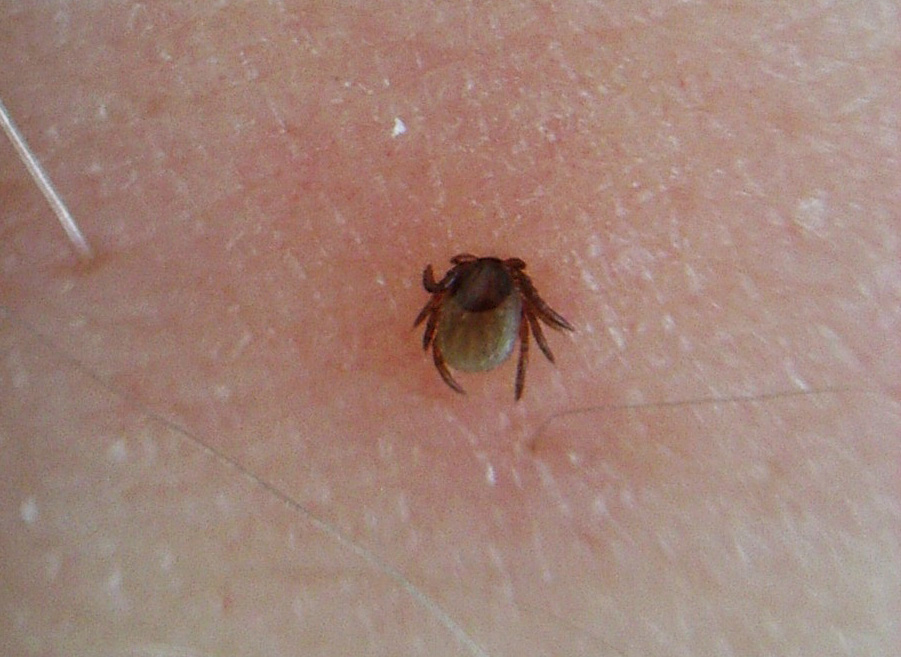
Source: Wikipedia
Ticks are on the march, expanding their geographic range and infecting more and more people. Yet tests that can detect tick-borne diseases (TBDs) have been developing at a crawl. Existing tests have limited diagnostic accuracy. Also, they cannot test for more than one infection simultaneously.
A new and hopefully better test, the TBD-Serochip, has been developed by scientists based at Columbia University. The TBD-Serochip, the scientists report, is not only more accurate than existing tests, it is also capable of multiplex detection and can detect Lyme disease and seven other TBDs.
Details about the new chip-based blood test appeared February 16 in the journal Scientific Reports, in an article entitled “A Multiplex Serologic Platform for Diagnosis of Tick-Borne Diseases.” According to this article, the TBD-Serochip can discriminate antibody responses to Anaplasma phagocytophilum, Babesia microti, Borrelia burgdorferi, Borrelia miyamotoi, Ehrlichia chaffeensis, Rickettsia rickettsii, Heartland virus, and Powassan virus.
Currently, the detection of B. burgdorferi, which causes Lyme disease, requires two separate tests. This cumbersome approach also relies on subjective criteria for the interpretation of results, and accurately identifies fewer than 40% of patients with early disease and results in false positives 28% of the time.
The accuracy of the method used to diagnose TBDs Babesia, Anaplasma, Ehrlichia, and Rickettsia infections varies widely among testing laboratories. And for other tick-borne agents, specific blood tests are not yet available, or in the case of the potentially deadly Powassan virus or Heartland virus, are only performed in specialized laboratories.
The new test, the authors of the new study reported, was evaluated as follows: “[We] examined sera from patients with confirmed Lyme disease, babesiosis, anaplasmosis, and Powassan virus disease. We identified a wide range of specific discriminatory epitopes that facilitated accurate diagnosis of each disease. We also identified previously undiagnosed infections.”
The study’s authors noted that each assay contains approximately 170,000 12-mer linear peptides that “tile along the protein sequence of the major antigens from each agent with 11 amino acid overlap.” This arrangement, the authors asserted, permits the accurate identification of a range of specific immunodominant immunoglobulin G (IgG) and IgM epitopes that can then be used to enhance diagnostic accuracy and integrate differential diagnosis into a single assay.
The TBD Serochip is also able to identify whether an individual is infected with more than one tick-borne pathogen. Individual ticks are frequently infected with more than one agent; Ixodes scapularis ticks alone can transmit at least five human pathogens. Evidence of exposure to other tick-borne pathogens in patients with Lyme disease has been well documented. In the new paper, the researchers report finding antibodies to another agent in 26% of blood specimens from patients with TBD.
As new tick-borne infectious agents are discovered, the TBD-Serochip will be modified to target them—a process the researchers say can be done in less than four weeks.
“The number of Americans diagnosed with TBD is steadily increasing as tick populations have expanded geographically,” said Rafal Tokarz, Ph.D., lead author of the new study.
“Each year, approximately 3 million clinical specimens are tested for TBDs in the United States. Nonetheless, the true incidence of TBDs is likely greatly underestimated, as patients with presumed TBDs are rarely tested for the full range of tick-borne agents, and only a fraction of positive cases are properly reported,” added Nischay Mishra, Ph.D., one of the study’s coauthors.
In addition to its utility as a diagnostic platform, the TBD Serochip also provides a powerful research tool for studies of TBDs. The technology can be employed to discriminate individual antibody responses in patients with TBD and thus examine the interplay of TBD agents on disease manifestation and progression. It can also be used to assess the impact of genetic diversity of tick-borne pathogens on the host immune response.
“Diagnosing tick-borne illness is a difficult journey for patients, delaying effecting treatment,” commented senior author W. Ian Lipkin, M.D., director of the Center for Infection and Immunity and John Snow Professor of Epidemiology at Columbia University's Mailman School of Public Health. “The TBD Serochip promises to make diagnosis far easier, offering a single, accurate test for eight different TBDs. Early detection of infection enables rapid and appropriate treatment.”


